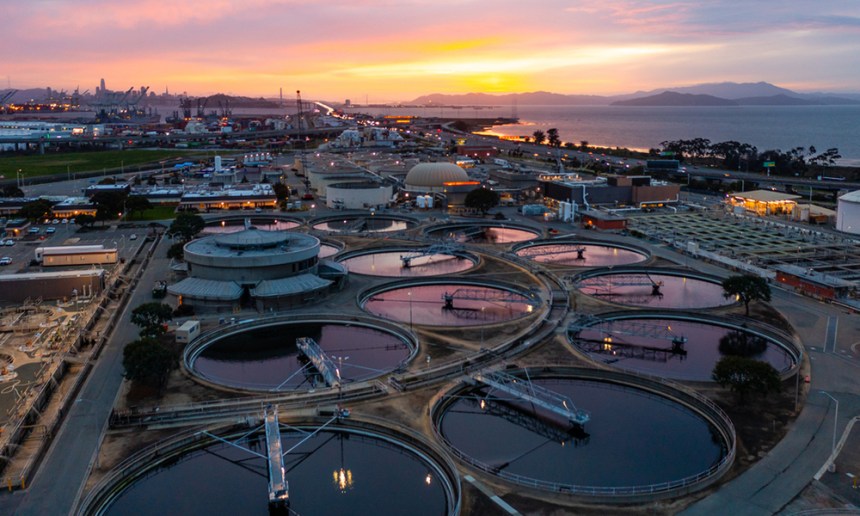Jessica Bradley outlines several innovative ways cities are closing the loop on food waste to save money, redistribute food to those who need it, and reduce carbon emissions.
Around a third of all food produced globally is wasted. Food waste is a critical global challenge, especially in cities, where 80% of the planet’s food is expected to be consumed by 2050.
Food waste on such a huge scale undermines the sustainability of our food systems and also wastes all the resources used to produce food, including water, land, energy, labour and capital.
The amount of food we waste has a huge economic impact; the global cost is currently estimated at approximately £770 billion a year.
Food waste also has huge consequences for planetary health. In 2022, more than one billion tonnes of food – equivalent to more than one billion meals a day – were wasted globally, which contributed to around 10% of global greenhouse gas emissions.
This is because food waste generates vast quantities of methane, which, over a century, is 25 times more potent than carbon dioxide.
In 2015, the EU’s member states signed up to UN Sustainable Development Goal (SDG) 12.3 to halve food waste by 2030. However, only $0.1bn was invested annually in 2019/20 globally to reduce food waste, despite the UN estimating achieving the goal would require $50bn in investment.
Global differences in food waste

In the global west, most food waste happens in shops and our homes, which requires solutions including smart refrigerators and food-sharing platforms, such as Too Good To Go, which allow businesses to sell leftovers that would otherwise be discarded.
With supermarket standards deeming so much fresh produce cosmetically unacceptable, there has been a rise in recent years in the availability of ‘wonky’ vegetables and subscription services, such as Odd Box.
In the global south, one-third of food is wasted before it reaches consumers, says Zachary Tofias, director of food and waste at C40, a network of cities and networks sharing sustainable practise.
This is often caused by inefficient handling and storage that exposes crops to adverse conditions and pest infestation, which causes rapid spoilage.
In recent years, digital innovation has enabled producers and farmers to continuously monitor food loss and waste, which involves using field sensors to monitor temperature, light, humidity and soil moisture.
However, this technology isn’t yet proportionately used in the countries that need it the most. China, which has the highest global population and output of fruit and vegetables, is also the world’s biggest Internet of Things (IoT) market.
India, on the other hand, has the second biggest population and fruit and vegetable output, but a far lower GDP and far less application and research around sensor technologies that monitor food waste in the supply chain.
Global solutions
 AI is one of the most recent innovations being widely implemented, not only on farms but also further down the supply chain. One example of how this is being done is by helping retailers forecast demand more precisely.
AI is one of the most recent innovations being widely implemented, not only on farms but also further down the supply chain. One example of how this is being done is by helping retailers forecast demand more precisely.
Aside from technological advancements, reductions in food waste also require collaboration and policy from local authorities, Tofias says.
One of their most important roles here is to work with the private sector, Tofias says. This, he continues, includes dedicating staff time to thinking about how to create platforms for the private sector to engage and educate the community.
One challenge, Tofias adds, is thinking about food in the context of the waste hierarchy, where surplus food is fed to humans, and edible food waste should be served to animals; with disposal being the final step.
“All steps before disposal are huge opportunities for innovation,” he says.
At Barcelona’s foodbank in Banc del Aliments, Tofias adds, food waste is sorted into two streams. Waste that’s in good condition is given to non-governmental organisations (NGOs) to produce jams and broths, for example, and everything else is composted.
While in Milan five waste hubs collect surplus food from supermarkets around the city and redistribute them to people in need via NGOs. Over 2022, the four hubs operating at the time recovered 400 tonnes of food.
The foodbanks were set up as a joint effort, including the City of Milan, Cariplo Foundation, Polytechnic University of Milan and Assolombarda – an association representing 6,000 businesses.
The organisers put the foodbanks’ success down to building good relationships and common goals with stakeholders, monitoring progress, and to local government prioritising educating citizens on how to prevent food waste.
“Milan created an incentive for businesses to identify surplus food that’s still edible,” Tofias says. “Now five hubs across Milan are feeding tens of thousands of people food that would have otherwise been thrown out.”

Cities that achieve significant food waste reductions employ a blend of regulation, incentives and public engagement, says Malachy Mitchell, managing director of international food and agribusiness consultancy Farrelly Mitchell.
Mandatory waste separation policies have proven very effective across the world, for example, he adds.
South Korea’s landfill ban and pay-by-weight system increased the amount of food waste recycled from 2% to 95% over the last 30 years.
In Seoul, the country’s capital, 6,000 bins contain scales and Radio Frequency Identification that weigh food waste and charge residents accordingly – reducing food waste in the city by a reported 47,000 tonnes in six years.
Alternatively, residents can buy biodegradable bags – which they’re required by law to use if they want to dispose of food – that cover 60% of the cost of collecting and processing food waste in the city.
Targeted interventions like this have produced promising results, says Mitchell. But meeting the SDG 12.3 will require successful policies to be quickly adapted and implemented on a global scale, he adds.
Common challenges

The biggest challenge facing countries and cities that need to reduce food waste is the magnitude of the problem, Tofias says. Since there are so many different causes of food waste, multi-level interventions are required.
For local authorities, one common challenge is insufficient data, says Mitchell.
“Tracking systems for waste management can only be found in 12% of the world’s nations, with the remaining 88% having to resolve the issue blindly until actionable data becomes available,” he says.
Another common obstacle, Mitchell says, is changing entrenched behaviours and cultural norms.
“Public awareness campaigns alone prove insufficient to shift habits rooted in convenience or social norms,” Mitchell says.
Changes, he adds, can only be implemented when stakeholders and systems align their interests.
“Many governments struggle to align all of their food system participants; even creating a consensus between farming communities and food manufacturers is a challenge,” he says.
Global successes

Only a handful of nations worldwide are achieving substantial reductions in food waste, says Mitchell.
One of those nations is France, whose agricultural ministry launched the National Pact to Combat Food Waste in 2013.
Then, in 2016, the country introduced the Garot Law, which required targeted retailers to offer a partnership with food aid associations and set up procedures for monitoring and controlling the quality of their food donations.
When it comes to household food waste, effective measures make avoiding food waste as effortless as possible.
New York City, for example, offers citizens a Food Portal under its donateNYC app and website, which matches food donors to organisations. In the first year, the portal saved nearly 80 tonnes of food from landfill.

In Oakland, California, efforts to reduce food waste are largely thanks to the East Bay Municipal Utility District’s (EBMUD) food scraps processing facility.
The wastewater treatment plant, located at the base of the Bay Bridge in Oakland, takes discarded food scraps from restaurants and supermarkets that usually go to the landfill and converts them into renewable energy.
“There are so many natural resources in the wastewater,” says Nelsy Rodriguez, public information representative at the EBMUD. “We saw a real opportunity to use those resources for fertiliser or to generate biogas, so we started a pilot.”
These food scraps include winery waste, as the plant is close to Napa, as well as domestic waste, fats such as oils and greases, and food and animal processing waste.
EBMUD generates enough energy from this waste to operate its plant, and the rest is sold to the grid.
“When we extract leftover organic matter from food scraps, we turn it into something beneficial for the environment and reduce our carbon footprint and reliance on fossil fuels,” she says.
“It spreads out and generates energy that would’ve otherwise been thrown into the bay or landfill and created more carbon.”
On average, EBMUD produces around 27,000 MWh from resource recovery every year. EBMUD is now looking for ways to expand the pilot.
“The fundamentals of wastewater haven’t changed over the last century, so we’re always looking for strategic innovations,” Rodriguez says.
In the global south, effective measures include innovations in preservation, like smart packaging and IoT sensors.
In Nairobi, the largest city in Kenya with a growing population, city markets have unreliable electricity connections, which contributes to food waste and loss. Research shows that one-fifth of food is wasted due to inadequate access to cold storage.
A pilot project implemented earlier this year in one city market involved installing a portable cold system with inbuilt, high-efficiency solar panels, which could be used all year round because of its ability to change to alternative power sources in cloudy conditions.
It’s estimated that expanding to all city markets could save around 21,613 tonnes of food waste from landfill.
Closing the loop on food waste
Ultimately, ending food waste requires shifting the narrative from the ‘make, take waste’ perspective to create circular economy solutions, Tofias says.
Experts agree that this shift needs to happen across all stakeholders. Mitchell advises local governments to start with comprehensive baseline studies to properly assess the scale of food waste, and identify key sources and trends.
Then, they can develop a multi-pronged strategy that combines regulatory measures, infrastructure investment and community engagement.
This could, he adds, include mandatory waste segregation and tax incentives for food redistribution charities.
“I’d advise local governments to create the right infrastructure by prioritising funding for composting facilities, anaerobic digestion plants, and surplus food networks,” he says.
In the West, since most food waste comes from households, reducing food waste will require huge shifts in attitudes and behaviours towards how we purchase, consume and discard food.
“We pay for waste to be taken away from us every week; we put out our garbage bins and people take it away from us, “ Rodriguez says. “This is where our thinking about it stops, but what we do with our waste is a huge global issue.”
The post How these cities are closing the loop on food waste appeared first on Circular Online.

